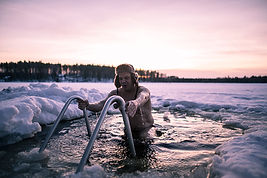CALL US
408 568 1226
Custom Sauna and Cold Plunge
Turning your outdoor living space into a Nordic inspired sanctuary.
Bringing together mind, body and soul

Benefits of Cold Water Immersion
Section Title
“It really is mystical stuff – you get the most incredible natural high. It's exciting to see how your body builds resilience – it just loves that feeling of being really cold! It can be very addictive.”
Reduce Inflamation
Cold water immersion has a strong anti-inflammatory effects due to the vasoconstriction and vasodilation of your blood vessels. As blood vessels constrict and dilate, the flushing of toxins and edema can help reduce inflammation in muscles and tissues. Athletes often turn to cold plunge therapy to expedite muscle recovery after intense workouts or competitions; it can alleviate muscle soreness and accelerate healing.
Mental Health
Cold water immersion induces the release of endorphins in the brain that promote feelings of well-being and relaxation. This endorphin release can reduce stress and improve mood, potentially helping individuals manage anxiety and depression.
The release of dopamine during cold exposure is linked to the body's stress response and the activation of the sympathetic nervous system. As the body senses the shock of cold temperatures, the brain releases dopamine as a part of its adaptive reaction, creating the sense of accomplishment and heightened mood that many individuals report following cold plunge therapy sessions.
Improve Circulation
and Immune Function
The alternation between blood vessel constriction and dilation promotes the circulation of lymph, a fluid containing immune cells and waste products. This enhanced circulation helps remove toxins, reduce fluid retention, and support immune system function.
Improved Sleep
Engaging in cold plunge therapy earlier in the day can help regulate the body's natural circadian rhythms. Exposure to cold water triggers the release of hormones like adrenaline and norepinephrine, which elevate alertness and mental focus. This can create a natural energy boost that tapers off as the day progresses, aligning with the body's daytime wakefulness and evening sleep patterns.
Weight Loss
Cold exposure prompts the body to generate heat to counteract the drop in temperature. One way the body achieves this is by increasing its metabolic rate, which leads to greater calorie burning. While the increase in metabolic rate might be relatively modest, repeated exposure to cold water can contribute to a cumulative effect that may aid in weight management over time.

Benefits of Sauna
Sauna bathing offers a wide variety of health benefits that include detoxification, increased metabolism, weight loss, increased blood circulation, pain reduction, anti-aging, skin rejuvenation, improved cardiovascular function, improved immune function, improved sleep, stress management, and relaxation.
Health, Wellness and
Not surprisingly, sauna bathers most frequently cite “stress reduction” as the number one benefit of sauna use. Studies show the majority of disease (e.g. heart disease) is at least partially stress-related. Decades of well-done, peer-reviewed sauna medical research have shown saunas to provide profound health benefits. A 25-year study conducted with more than 2,300 participants at the University of Eastern Finland by Dr. Jari Laukkanen and his colleagues revealed regular sauna use improved cardiovascular health among many other health benefits. In short, regular sauna bathing is a wonderful, feel-good and good-for-you addition to your overall health and wellness plan.
Flush Toxins
Due to the heat of a sauna, the core body temperature begins to rise. Sweat production is primarily designed to cool the body, and is composed of 99% water. However, deep sweating in a sauna can help reduce levels of lead, copper, zinc, nickel, mercury and chemicals - which are all toxins commonly absorbed just from interacting with our daily environments.
Heart Health
In the high temperatures of a traditional or infrared sauna, skin heats up and core body temperature rises. In response to these increased heat levels, the blood vessels near the skin dilate and “cardiac output/circulation” increases. Medical research has told us that the heart rate can rise from 60-70 bpm (beats per minute) to 110-120 bpm in the sauna (140-150 bpm with more intensive bathing), and can often sink to below normal after the cooling off stage. Regular sauna usage has been shown to reduce the risk of all-cause mortality and fatal cardiac incidents along with reduced risk of stroke and hypertension.
Weight Loss
Outlandish claims are often made by some sauna sellers to promote saunas as an end-all weight loss tool. While some individuals may experience high amounts of calorie burn at first - particularly those individuals in poor shape to begin with - over the long term, saunas are simply treated as one of many tools in our arsenal when it comes to burning additional calories. The sweating process itself requires a notable amount of energy. That energy is derived from the conversion of fat and carbohydrates in a bodily process that burns up calories. According to U.S. Army medical research (Ward Dean, M.D.), “A moderately conditioned person can easily sweat off 500 grams in a sauna in a single session, consuming nearly 300 calories in the process.” The body consumes said calories due to the acceleration of heart activity (see section 2 on Heart Health). As heart activity increases and as these processes demand more oxygen, the body begins to convert more calories into usable energy.